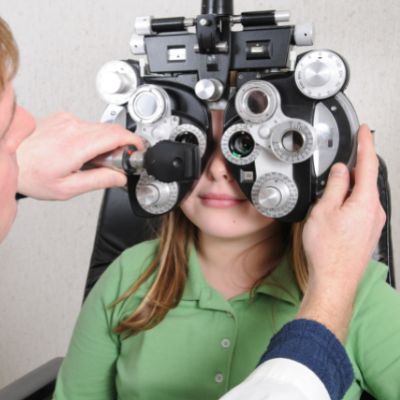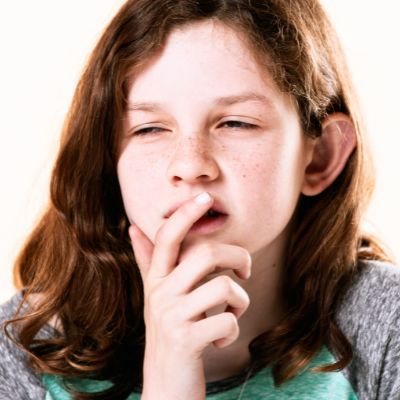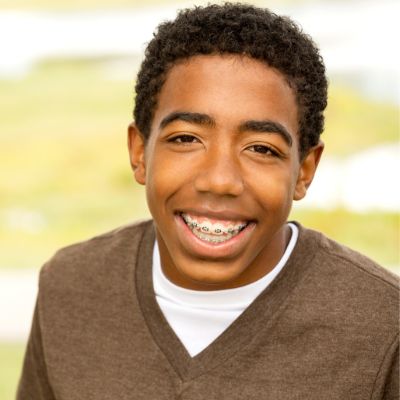According to Education Week, federal data has shown that 1 of every 3 schoolchildren in the United States hasn’t had an eye exam in at least two years. Furthermore, researchers found that nearsightedness has almost doubled since the 1970s and the need for corrective eyewear continues to grow. If you want to protect your child’s eyesight then it’s important to get your child’s vision care routine started at an early age.
To start your child on the road to healthy vision, you’ll need to know the basics of kid’s eye exams. This includes when they should have their first exam, what to expect, and how to prepare them for it. It’s also important to know the signs that your child may be struggling with their vision. Be on the lookout for squinting, trouble focusing in school, as well as tilting their head or covering one eye to see. Older kids and teenagers will benefit from daily contacts to keep their eyes safe and feeling comfortable.
Kids’ Eye Exams: The Basics
Just as with oral and overall health, looking after your child’s eye health starts at an early age. As the Center for Disease Control (CDC) has pointed out, less than 15% of preschool kids get eye exams. On top of that, less than 22% of them receive actual vision screenings.
To set your child up for a lifetime of healthy eyesight, you need to know:
- When your child should have their first eye exam
- What to expect during a child’s eye exam
- How to prepare your child for their first eye exam
Taking your child to their first eye exam helps to catch any underlying issues that may be present. Pediatric eye exams can vary depending on your child’s age, so it’s good to know what to expect. This will also help you prepare your child for their exam so they’re not nervous.
When Your Child Should Have Their First Eye Exam
Children should have their first eye exam between the ages of 3 and 5 years old. This age period is the perfect time to catch risk factors or signs of pediatric eye problems and address them quickly.
You may remember getting vision screenings at school when you were little. While these are helpful for catching some issues, kids can still manage to pass them even if they have focusing issues or other eye problems. They also don’t allow for examining the back of your child’s eyes to check for eye diseases.
Comprehensive eye exams are the best way for optometrists to get an accurate understanding of your child’s vision. They involve a series of tests to check multiple aspects of their vision while providing insight into their overall health as well. For instance, comprehensive eye exams can check for astigmatisms, as well as check for signals of larger health concerns your child may be experiencing.
Click here to learn more about comprehensive eye exams in Knoxville and what to expect!
What To Expect During a Child’s Eye Exam
How optometrists approach a pediatric eye exam can vary depending on your child’s age. After all, an older child with verbal or reading skills can communicate more easily than a toddler.
Eye Exams for Toddlers
During an eye exam for your toddler, our optometrists at Hardin Valley Eyecare & Optical will want to check how they respond to changes in light, if their eyes are lined up correctly, and how well their eyes move.
Your child will also be examined for:
- Nearsightedness
- Farsightedness
- Astigmatism
- Amblyopia
Also known as myopia, nearsightedness means that it’s easy for your child to see objects that are close up. However, objects appear blurry if they’re far away. Farsightedness, or hyperopia, poses the opposite problem. If your child is farsighted then it’s easier for them to see far away objects while closer ones appear blurry. Astigmatism occurs when a child has a misshapen eye. This can cause your distance and near vision to become blurred. 
More commonly known as lazy eye, amblyopia is the result of one eye being stronger than the other. This problem is caused by the area of the brain that controls the weak eye not completely maturing. It’s the most common type of vision issue in children and can make it difficult for them to make out details.
Fortunately, amblyopia can be corrected if it’s caught early enough. This can be done with glasses, but sometimes wearing an eye patch is necessary. This forces the weak eye to focus, become stronger, and develop properly. Early detection is key for amblyopia since it can be harder to treat as your child gets older.
Eye Exams for Older Kids
Children ages 3 to 5 will receive both a physical exam and vision screening from their optometrist. These vision screenings may include looking at:
- Eye charts
- Letters
- Pictures
Their optometrist may also perform the Random E’s Visual Acuity Test. More commonly known as the “tumbling E game,” this test helps eye doctors determine how well children can make out the form and details of objects. The game involves looking at a vision chart with multiple capital Es that face different directions, but it can also be performed with fingers.
The goal of the game isn’t to identify the letter. Instead, the optometrist will have your child tell them which way the E is facing. This makes it easy for kids who haven’t learned how to read or who are non-verbal. It’s also ideal for kids with learning disabilities like dyslexia since it only involves pointing.
How To Prepare Your Child for Their First Eye Exam

Kids are often nervous when visiting the doctor, and the eye doctor can be no different. That’s why it’s important to talk to them beforehand about what to expect. This gives them time to understand what’s happening and why, and assures them there won’t be shots or anything painful.
Explain to your child that it will take at least 30 – 45 minutes to complete the exam. While they may not be as scary as shots, kids can still be scared of eye drops. Help them to understand that they’re very important for helping the eye doctor keep their eyes healthy.
Practice Makes Perfect
It can be helpful to practice using eye drops with your child. This can help them get used to the process and feeling so they won’t be scared when it’s time for their appointment. It’s important to build up to real eye drops slowly. Start by pretending to put eye drops into a favorite stuffed animal or doll. Your child can even pretend to be an optometrist and use a magnifying glass to look in their stuffed animal or doll’s eyes.
Once they’re used to this, you can pretend to put eye drops in your child’s eyes. You can also use a magnifying glass to “examine” their eyes so they can get used to the experience. Finally, you can practice putting eye drops in their eyes.
Following this process can make going to the optometrist feel more like a game than a visit to the doctor. You can also practice the “tumbling E game” with them and help them feel like visiting the optometrist can actually be fun.
For more information about vision exams for children in Knoxville, TN, click here!
Signs That a Child Is Struggling With Their Vision in School

If you’ve never brought your child for a vision exam in our Hardin Valley optometry office then have no fear. There are some signs you can look for or ask their teacher about that may indicate a vision problem.
This could be:
- Squinting
- Difficulty focusing in school
- Sitting too close to screens or holding devices too close
- Tilting their head or covering one eye to see better
- Constantly rubbing their eyes
If they have any of these signs then it’s a good idea to bring them in for an exam. Dr. Travis Thompson and Dr. Catherine Abbott can perform the necessary tests to check their vision and provide solutions for their vision problems.
Squinting
Squinting is one of the most common signs that your child is struggling to see clearly. Everyone has squinted to see better from time to time, but squinting constantly to see is a clear sign of a problem. This is as true for children as it is for adults.
Squinting a lot is usually caused by a refractive error. When working properly, light enters through the cornea and then through the pupil, lens, vitreous humor, retina, optic nerve, and finally into the brain. Once there, it’s translated into the images we use. Unfortunately, this process can be interrupted due to a misshapen eye, resulting in vision problems.
Refractive errors can affect your vision in different ways, and some are more common than others. Common refractive errors include:
- Astigmatism
- Nearsightedness
- Farsightedness
Dr. Travis Thompson and Dr. Catherine Abbott can diagnose what’s causing your child’s refractive error and provide corrective eyewear or other treatment to help them see clearly.
Difficulty Focusing in School
Classrooms are much more complicated now than when you were young. Back then, all you had to focus on was your books and the whiteboard. But now there are multiple things requiring your child’s attention including computers, tablets, and many other educational aids.
It can be difficult for any child to focus in this kind of environment, but it’s especially hard for kids with undiagnosed vision problems. Kids who have to squint or use other coping mechanisms can have more trouble paying attention and eventually fall behind. In some cases, what seems like an attention issue may actually be vision-related.
Sitting Too Close to Screens or Holding Devices Too Close
Parents have worried about the effects of screens on their kids’ vision ever since they entered our living rooms. Now digital screens are the center of our lives, whether they’re smartphones, computers, or tablets.
It’s not uncommon for kids to sit too close to the television or hold digital devices too closely. While this can cause a lot of worry for parents, your child’s vision is safer than adults who do the same thing. Researchers have found that kids actually experience less eye strain than adults who sit too close to the television or hold screens too close.
However, this may be a sign of nearsightedness if your child can’t see without sitting close or holding screens closely. To tell the difference, ask your child why they’re doing it. If it’s just a habit then you don’t have anything to worry about. If they’re doing it to see better then you should set up an appointment for them with our optometry office in Knoxville, TN.
Tilting Their Head or Covering One Eye To See Better
Tilting their head or covering one eye to see better can be a major sign of a vision problem. This is a way to compensate by adjusting their angle of vision in order to see more clearly. In many cases, a child tilting their head or covering their eye is a sign of “lazy eye” (amblyopia).
Lazy eye is caused by the brain and eyes not working together properly. This can be the result of your child’s eyes being misaligned (strabismus) or a refractive error such as astigmatism, nearsightedness, or farsightedness. Getting treatment for your child as early as possible can prevent this from becoming permanent, but even older kids can still benefit from treatment.
The two main treatments for lazy eye are atropine and patching. Atropine is a type of medicated eye drop that’s put in the stronger eye to weaken it. This forces the weak eye to work harder and stimulate the “vision part” of the brain. Patching has similar results, except an eye patch is placed over the strong eye instead of using eye drops.
Constantly Rubbing Their Eyes
Rubbing your eyes is a common sign that you’re suffering from fatigue or eye strain. Children who rub their eyes a lot may be overworking their eyes, which can be a sign of a vision problem. It can also be a sign of dry eyes in some cases.
Dry eyes are a common symptom of looking at digital screens. Blinking helps keep our eyes lubricated by spreading tears, but people tend to blink less when looking at digital screens. While not a vision problem like a refractive error or lazy eye, rubbing their eyes due to dryness can point to staring at screens too long.
One tip to teach your kids is the 20-20-20 rule to keep their eyes moisturized All they have to do is look at something:
- 20 feet away
- For 20 seconds
- Every 20 minutes
This ensures their eyes get regular breaks and stay comfortable throughout the day.
Click here to learn more about signs that your child needs a vision exam in Knoxville, TN!
Vision Care for Teens: Daily Contact Lenses

Your kids will always be your kids, even as they become teenagers and young adults. In some cases, your kids may want to ditch glasses for contacts. While this doesn’t seem like a big deal, it’s important for parents to understand that not all contact lenses are created equal. That’s why Dr. Travis Thompson recommends daily contacts, especially for kids and teenagers.
Some contacts can be worn for a week or even a month. However, these are ideal for people with a set schedule that gives them time to remove and clean them on a regular basis. Kids, teens, and young adults, on the other hand, can lead hectic lifestyles and easily forget. Neglecting to take proper care of your contacts could result in serious vision problems later on, including eye infections and even corneal ulcers.
With daily contacts, you don’t have to worry if your child or teenager is wearing them for too long. They’re designed so that a new pair is used every day, ensuring that they can see clearly while keeping their eyes comfortable and safe.
According to Dr. Travis Thompson:
I recommend everyone wear daily lenses—especially children and teens. Daily lenses are disposable—you put them in and take them out in a single day, then toss them. They take a lot of the responsibility out of contact lens wear because you don’t have to clean the lenses or change them at a certain time—and you only touch the lens twice.
For more about why to choose daily contacts in Knoxville, TN, click here!
He goes on to explain that “Daily lenses are the healthiest choice because they have the lowest rate of getting eye infections, are easiest to comply with safe-use practices, and they also keep the eye comfortable the longest.”
Many people worry about the cost of daily lenses, but he believes this is a misconception. According to Dr. Travis Thompson, “Daily lenses may be more expensive up front, but when you factor in how much you are paying for contact lens solution and office visits due to infections, it evens the price out.”
Are you ready to get your child started on a lifetime of healthy vision? Contact us today to schedule your child’s eye exam!
Your child should have their first eye exam between the ages of 3 and 5. To help them through their first visit, learn what to expect, and help prepare them so they feel as comfortable as possible. You should also be able to spot the signs that your child is struggling with their vision. This may include rubbing their eyes a lot, struggling to focus in school, as well as covering one eye or tilting their head to see. If your older child or teen wants contacts, consider daily lenses.
Hardin Valley Eyecare & Optical has been serving Knoxville since 2009. Dr. Travis Thompson and Dr. Catherine Abbott specialize in the diagnosis and treatment of a wide array of eye diseases, conditions, and problems and are committed to improving the quality of life in the Knoxville community through enhanced vision. Located at 10904 Spring Bluff Way, you can schedule an appointment online or give us a call at (865) 888-0892.





